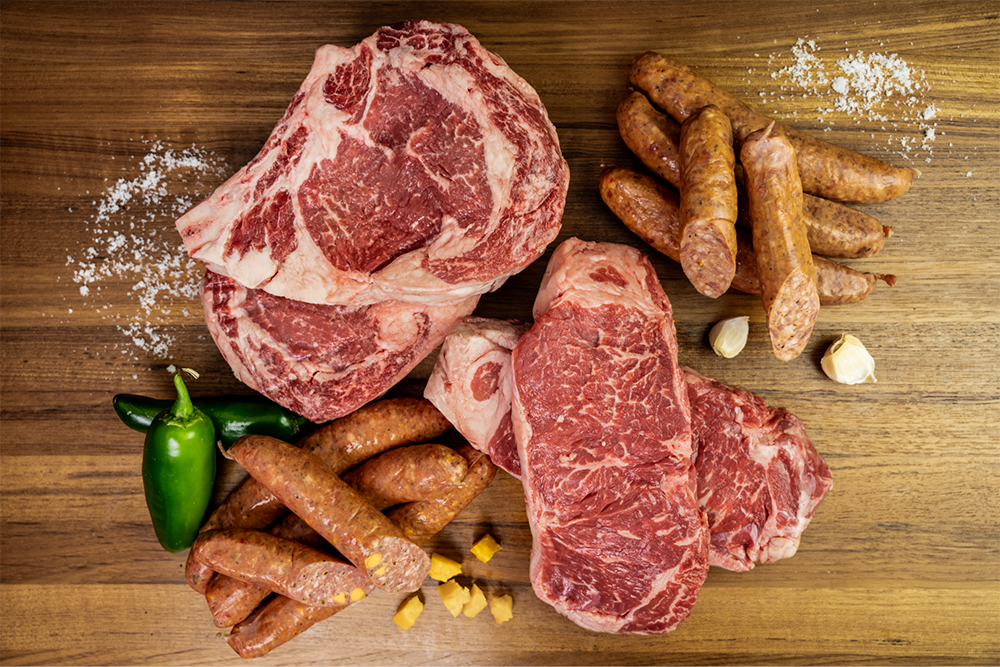Why Citizens Love Bagley Farms Meat Market Edwardsville IL for Their Meat Buying
Why Citizens Love Bagley Farms Meat Market Edwardsville IL for Their Meat Buying
Blog Article
Discover the Art of the Butcher's Cut in a Modern Meat Market
In the ever-evolving landscape of modern-day meat markets, the butcher's cut has actually transcended its standard roots, merging age-old workmanship with modern methods. Today's butchers are not simply processors of meat; they are knowledgeable artisans that highlight sustainability and honest sourcing. Their competence in picking and preparing cuts tailored to details cooking requirements provides an exceptional dining experience. What truly establishes the contemporary butcher apart is their ability to build a deeper link in between consumers and the beginnings of their meat. Exactly how do these masters equilibrium custom with development, and what implications does this have for the future of meat usage?
Development of Butchery Techniques
The development of butchery strategies mirrors an abundant tapestry of development and adjustment driven by developments in technology, changes in customer need, and a much deeper understanding of meat science. Historically, butchery was a craft gave with generations, with methods sharpened over centuries to maximize yield and taste. However, the commercial revolution ushered in automation, changing conventional techniques and enabling massive handling.
The mid-20th century saw butchery methods further refined by scientific understandings right into muscular tissue biology and meat aging, enhancing both tenderness and taste. Technologies like vacuum cleaner packaging and refrigeration extended item shelf-life, allowing butchers to diversify offerings and enhance quality assurance. This duration additionally noted the surge of specialized equipment, such as band saws and meat slicers, which enhanced precision and effectiveness in meat handling.

The 21st century has actually presented electronic innovation into the butchery realm. Computerized systems now aid in monitoring pet provenance and maximizing cuts to satisfy certain client preferences. Additionally, a resurgence in artisanal butchery has arised, mixing standard skills with modern knowledge to provide to customers seeking ethical and lasting meat alternatives. This development highlights a dynamic interaction between tradition and innovation, conference modern demands while maintaining the craft's heritage.
Comprehending Meat Cuts
Comprehending the complexities of meat cuts is essential for both butchers and consumers looking for quality and value. For butchers, specific cuts reflect skill and regard for the craft, ensuring very little waste and optimum yield.

Comprehending muscle make-up is critical; muscular tissues used more regularly by the animal tend to be harder and are best fit for slow food preparation techniques, while less-used muscles, like those located in the loin, are much more tender and ideal for cooking or roasting. Experience with these differences equips consumers to make enlightened choices, boosting their culinary undertakings.
Choosing Quality Meat
Choosing the best meat entails more than just choosing an aesthetically enticing piece from the screen. The art of choosing top quality meat requires a discerning eye and understanding of details attributes that represent quality and quality.
Secondly, take into consideration the marbling, which describes the white streaks of fat within the muscle. Proper marbling is a crucial indication of inflammation and taste, as it thaws throughout cooking, enhancing the meat's juiciness. Remember, higher marbling typically associates with superior high quality cuts, such as USDA Prime.
Appearance is an additional essential factor; meat should feel firm to the touch, not slimy or overly soft. Additionally, bear in mind the scent. Fresh meat should my latest blog post have a clean, neutral smell, totally free from any sour or off-putting odors.
Pairing Cuts With Food Preparation Approaches

On the other hand, harder cuts like brisket and chuck roast are abundant in collagen, which breaks down into gelatin when prepared gradually. These cuts are ideal for braising or sluggish roasting, enabling the meat to soften with time and develop deep, complicated tastes. Cuts such as brief ribs and pork shoulder fare well with slow-cooking methods, where prolonged cooking times transform their robust structures right into succulent meals.
Lamb shanks and oxtail, which need extended food preparation to soften, are excellent prospects for cooking or slow-moving simmering. These approaches coax out abundant, passionate tastes while More Info keeping dampness. By recognizing the one-of-a-kind features of each cut, cooks and home chefs alike can boost their cooking developments, making certain each recipe is both pleasing and unforgettable.
The Butcher's Function Today
Browsing the progressing landscape of the modern meat market, the butcher's function today extends past mere prep work of cuts. Contemporary butchers are culinary artisans, instructors, and advocates for lasting practices.
Along with crafting precise cuts, butchers currently engage directly with consumers, providing cooking suggestions and tailoring options to suit specific requirements and choices. Their know-how in meat aging, marbling, and flavor profiles equips customers to make informed choices, boosting their culinary experiences. This individualized solution exemplifies the butcher's progressing duty as a trusted advisor in the kitchen area.
In addition, butchers are critical in lessening waste, making use index of whole animals to produce varied items such as sausages and supplies. This comprehensive method not just values the pet but also lines up with modern sustainability objectives. By doing this, the modern butcher embodies both custom and advancement, adjusting to an ever-changing market while maintaining the virtuosity and integrity of their craft.
Conclusion
Mastery in understanding diverse meat cuts and top quality signs equips butchers to provide enlightened referrals, lining up particular cuts with optimal food preparation techniques. By honoring historic methods while embracing modern demands, the butcher's role continues to be crucial in today's sophisticated meat market.
Report this page